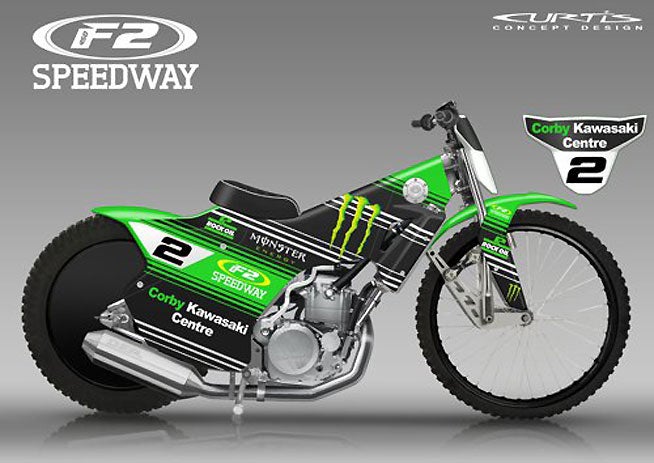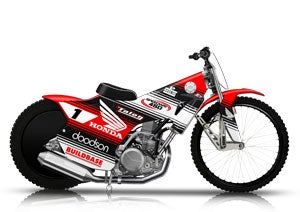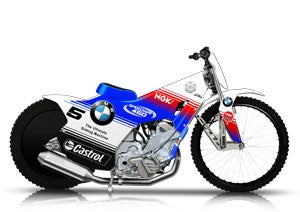Mass-produced, mainstream motorcycle engine brands have been used in “Class A” speedway racing before. Can F2 Speedway bring them back?

F2 Speedway is a new idea whose timing may be perfect to reintroduce mainstream brands such as the Japanese Big Four and European brands such as KTM, Husqvarna and Beta to the exciting sport of speedway motorcycle racing. Plans are underway for a new British Championship series that will spur the growth of the concept without infringing upon the existing speedway championship formats and technical structures throughout the world. The main goal is to foster interest and participation in this high-action sport by offering a rules package that keeps maintenance costs low. If successful, it could have a profound impact on the grand old sport of speedway, which will celebrate its centennial in 2023.
Okay, wait. We’d better put the brakes on right here (funny because speedway bikes don’t have any) and admit that we’re calling F2 Speedway a “new” idea when in fact the roost-hurling powerslide sport’s pre-World War II history includes the names of well-known brands of the era. Harley-Davidson, Indian and BSA all manufactured engines for tackling half-mile and quarter-mile shale and cinder tracks before Hitler copped an attitude. British manufacturer Scott Motorcycles, even went so far as to produce a supercharged engine for the sport. But as “Win on Sunday, Sell on Monday” shifted into high after the war, more stock was placed in the competitive exploits of the actual machines that were on dealer showroom floors than on overall brand performance image. Motorcycling’s major manufacturers gracefully bowed out of speedway racing, leaving smaller firms like Czechoslovakia’s Jawa and England’s JAP to fill the demand of the power-hungry steelshoe-clad skidders. Speedway continued to be a huge spectacle in Europe, with 90,000 fans jamming hallowed venues such as England’s Wembley Stadium to witness dramatic World Championship events.
 Things have changed very little since then. Wembley no longer hosts races, but the sport is still going strong in Europe, with a thriving Grand Prix format that determines the World Champion and a vibrant league-style and club format that serves as a feeder to the GPs. In America, pockets of dedicated racers and fans exist from coast to coast, with the most famous venue being the eighth-mile bullring at the Orange County Fairgrounds in Costa Mesa, California.
Things have changed very little since then. Wembley no longer hosts races, but the sport is still going strong in Europe, with a thriving Grand Prix format that determines the World Champion and a vibrant league-style and club format that serves as a feeder to the GPs. In America, pockets of dedicated racers and fans exist from coast to coast, with the most famous venue being the eighth-mile bullring at the Orange County Fairgrounds in Costa Mesa, California.
So, if the sport is doing so well, why is there be a need to introduce a new concept that could revolutionize it? Two words: rising costs. There are currently just two suppliers of speedway engines throughout the world. JRM (formerly known as Jawa) in the Czech Republic and GM of Italy, and the highly specialized machines are neither cheap to build nor maintain. A current speedway machine can cost from $7500 upward, and the ever-increasing power levels extracted from the 70+-horsepower, machines require careful maintenance to avoid reducing an engine that can have that much again in performance work into a worthless lump of alloy.
Lower parts costs are partially what gives the F2 concept a chance at success. The brainchild of 70-year-old Pete Seaton, an ex-rider and enthusiast who has remained actively involved within the sport for decades, the F2 concept is designed to use 450cc motocross engines in conventional speedway chassis, and the engines burn gasoline instead of methanol alcohol.
 Seaton has put his money where his mouth is, too. With no outside funding, he has built three race bikes, using Honda, BMW and Kawasaki engines, and they have undergone testing by several riders, including 1982 World Speedway Championship Runner-up Les Collins, who has given the project two thumbs up. The F2 concept has also received influential endorsements from former World Champions Mark Loram and Jason Crump as well as former British Champion Joe Screen. Crump has already begun building his own machine, using a KTM engine for power.
Seaton has put his money where his mouth is, too. With no outside funding, he has built three race bikes, using Honda, BMW and Kawasaki engines, and they have undergone testing by several riders, including 1982 World Speedway Championship Runner-up Les Collins, who has given the project two thumbs up. The F2 concept has also received influential endorsements from former World Champions Mark Loram and Jason Crump as well as former British Champion Joe Screen. Crump has already begun building his own machine, using a KTM engine for power.
The other thing that F2 has going for it is that it already has its own championship, as the British Speedway Control Bureau has given its blessing for an individual championship in 2014. This is critical because, unlike previous attempts to introduce a mass-produced engine into the sport, the F2 machines will race against each other and not be thrown into the lion’s den against the well-established and highly specialized 500cc JRM and GM powerhouses.
British vehicle designer Dave Curtis of Curtis Concept Design Ltd. Curtis has had a life-long passion for speedway motorcycle racing, and when he read about Seaton’s plans, he was inspired to produce the illustrations you see here.
“I have often thought that the latest generation of four-stroke MX engines would make great sense in a speedway class, but people within speedway always said that it wouldn’t work (due to the small flywheels, tires, etc.),” Curtis said. “Pete was the first person I was aware of who was actually trying it out in the metal, and he has now built four bikes himself. The project is still in its infancy, but having seen the bikes in action, I am convinced of their potential. The setup, tyies and track preparation may all have to vary from conventional speedway, but the end result is still unmistakably speedway!”
As much as Curtis loves Jawas and GMs, he feels that one of speedway’s major hindrances has always been the lack of mainstream manufacturer involvement, so his illustrations show an obvious link to motocross in terms of the branding, colors and associated mainstream sponsors.
“One thing we are keen to stress, is that this shouldn’t be seen as a threat to the existing speedway scene,” Curtis said. “It is more a case of trying to open things up and attract riders from outside regular speedway, and offer them a more cost-effective way to get sliding.”
for more information, visit www.F2speedway.com
 Your Privacy Choices
Your Privacy Choices